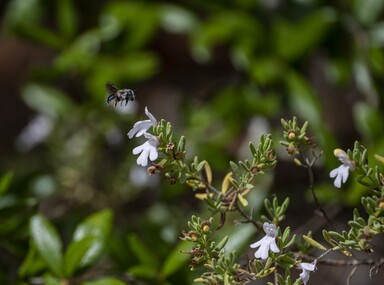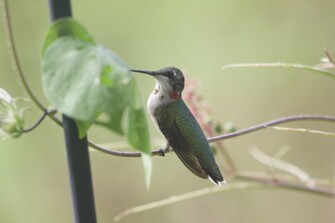 Little Yellow Butterfly.
National Pollinator Week was created fifteen years ago with unanimous approval from the United States Senate. What started as one nation’s effort to tackle the pressing issue of declining pollinator populations has expanded into a worldwide celebration of pollinators and their unique role in the environment. Bees, birds, butterflies, bats, beetles, moths, wasps and flies help plants reproduce by taking pollen from flower to flower. Flowering plants rely on pollinators, which means so do all the animals that get food from those plants, including humans. This edition of Kite Tales is dedicated to our pollinator friends.
 A Blue Calamintha Bee hovers over a blooming Ashe’s Calamint. Photo by Florida Museum/Kristen Grace.
This past April, Great Florida Birding and Wildlife Trail staff took a trip to see the unique creatures of Ocala National Forest. This vast wilderness of well over 300,000 acres contains the world's largest contiguous sand pine scrub forest and is famous among birders for providing habitat for the world’s largest Florida Scrub-jay population. Scrub habitats are dominated by shrubby trees, small plants and open sandy patches with taller trees scattered across the landscape. Keep an eye out while driving along the forest’s access roads and you might see a sentinel Scrub-jay perched on a taller tree, keeping watch on behalf of its family. These intelligent, curious birds like to watch people almost as much as people like to watch them.
On this visit, the Scrub-jays were not the main attraction. We were there to see something even rarer and much less well-known: the Blue Calamintha Bee (Osmia calaminthae)! This small, navy-blue bee is found only in Florida’s Marion, Polk and Highlands Counties. It is named for its main host plant, Ashe’s Calamint, a small, imperiled shrub with tiny, pale lavender flowers that bloom mainly in spring. When Ashe’s Calamint isn’t blooming the bee visits the even rarer False Rosemary, which is federally designated as endangered. With all these rare species linked in such a unique environment, the bee has sparked significant scientific interest. The Florida Museum of Natural History and its partners are conducting studies to understand the bee, its host plant relationships and their role in Florida’s scrublands.
The Blue Calamintha isn’t the only blue bee out there. Florida is home to at least five other bee species in the same genus, Osmia, also known as the mason bees. Many share a similar metallic navy hue. The name ‘mason bee’ comes from their nesting behavior. Unlike honeybees they don’t live in groups and build hives. Instead, individual bees construct small nests, often using mud, in hollow stems or tree cavities. Unlike its relatives the Blue Calamintha nests underground, nestled in the root systems of plants that stabilize the scrubland sands. These nests are almost invisible to the untrained human observer. The best way to distinguish the Blue Calamintha from other mason bees is by looking at its host plants and observing the behavior of bees that visit the flowers. The Blue Calamintha Bee displays a swift, distinctive head bob as it collects pollen by rubbing its facial hairs against flowers. However, this head bob can be too fast to reliably observe, so scientists look at the bee’s facial features under high magnification to avoid misidentification.
Like many other pollinators, the Blue Calamintha Bee faces threats to its habitat that can negatively impact its host plants. Encroachment from agriculture and development has fragmented and degraded Florida’s unique scrubland across the state. However, the bees have been found on restored lands that were converted from citrus groves back to scrub, a hopeful sign.
Learn more about the Blue Calamintha Bee here.
Planning a visit to Ocala National Forest? Check out Alexander Springs and Salt Springs on the Great Florida Birding and Wildlife Trail.
 Young male Ruby-throated Hummingbird, with red throat feathers just beginning to grow in. Photo by Travis Blunden.
While everyone knows hummingbirds drink nectar, their role as pollinators is often overlooked. Found only in the western hemisphere, hummingbird beaks are adapted to dip into their preferred flowers when feeding, leaving a scattering of pollen along their feathers that is transferred to the next blossom. The Ruby-throated Hummingbird is the most common hummingbird in Florida, named for the striking red color of the male’s throat. Like many other hummingbirds, these feathers are iridescent, meaning their color changes depending on how the light hits them. From a different angle the shining red patch may appear black. Both males and females have a whiteish-grey underside and metallic green across their heads and back, with the male having a more obvious forked tail. They are about three inches long with a wingspan of about four inches and weigh just 0.1 to 0.2 ounces.
Every year these tiny birds migrate thousands of miles from their wintering grounds in Mexico and Central America to the eastern and central United States and into parts of southern Canada. To sustain the enormous amount of energy required for this feat they feed on small spiders and insects for protein and fat as well as consume large quantities of nectar, pollinating plants along the way. Some Florida-friendly hummingbird favorites include coral honeysuckle, red buckeye, coralbean, firebush and trumpet creeper. Plant them in your yards and communities to help hummingbirds.
Check out our Planting a Refuge for Wildlife guide to attract more creatures to your yard. Order yours here!
|